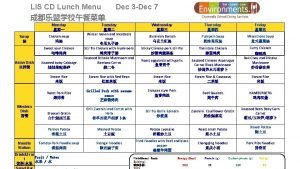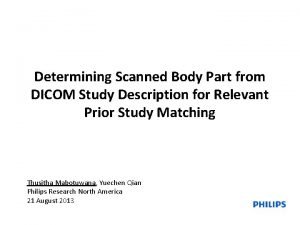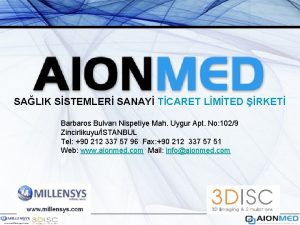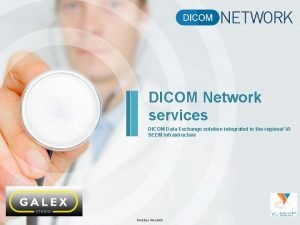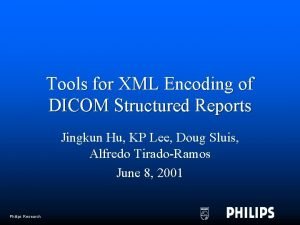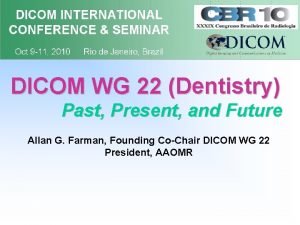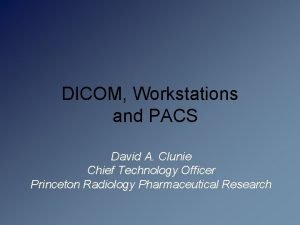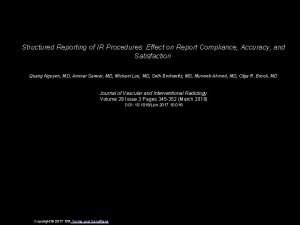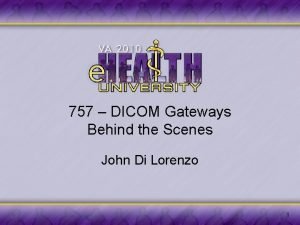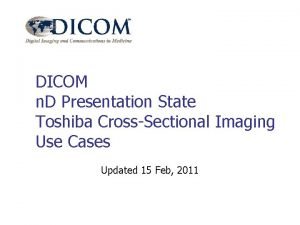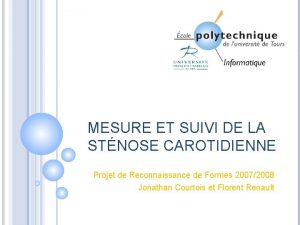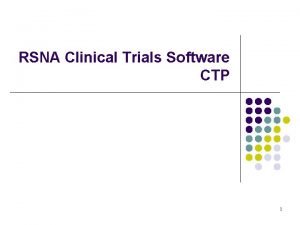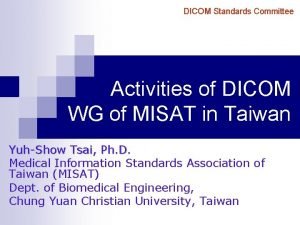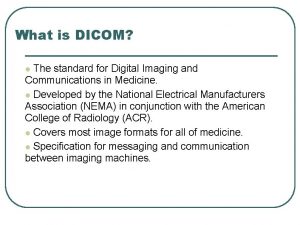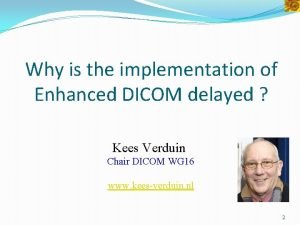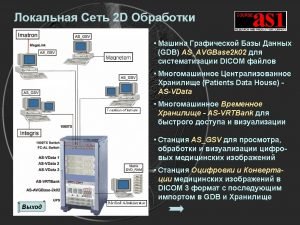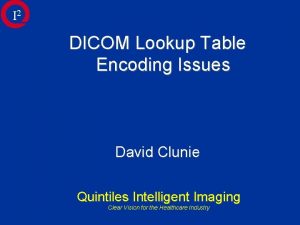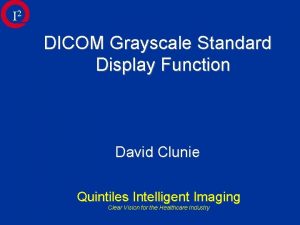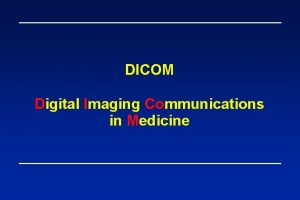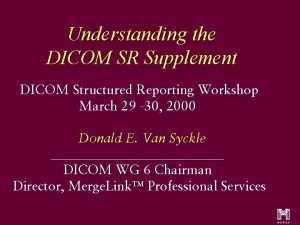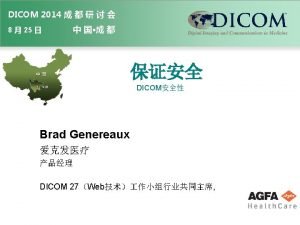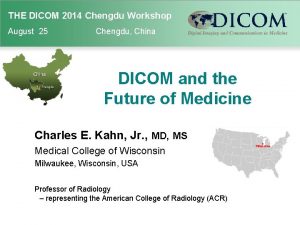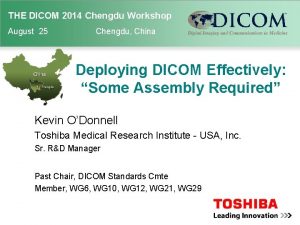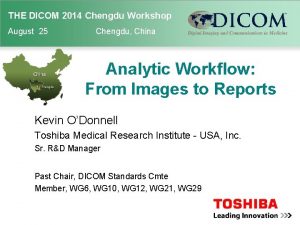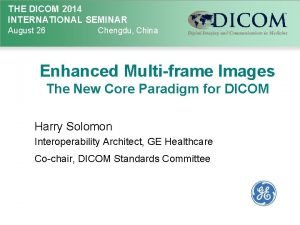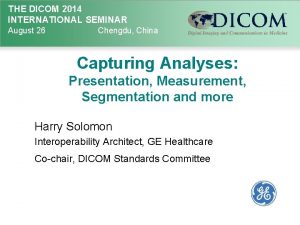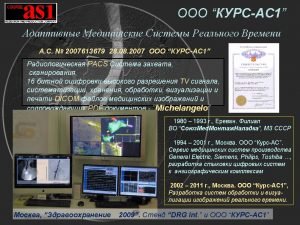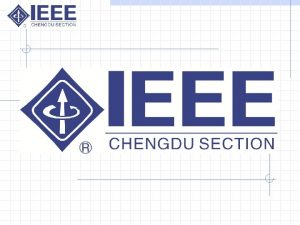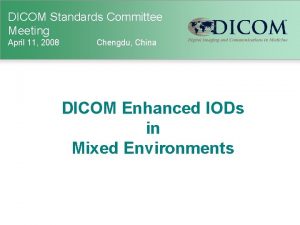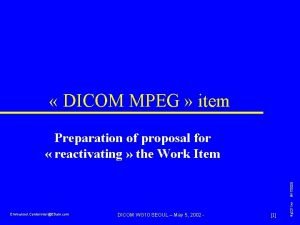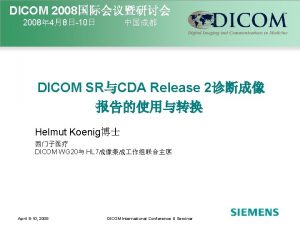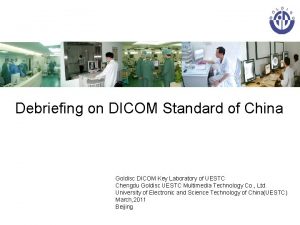THE DICOM 2014 Chengdu Workshop August 25 Chengdu























- Slides: 23

THE DICOM 2014 Chengdu Workshop August 25 Chengdu, China DICOM Overview: Stability and Evolution Kevin O’Donnell Toshiba Medical Research Institute - USA, Inc. Sr. R&D Manager Past Chair, DICOM Standards Cmte Member, WG 6, WG 10, WG 12, WG 21, WG 29

DICOM: A Family of Protocols Protocol • Specifies how two systems exchange information Many kinds of Systems: • Modalities, PACS, RIS, Workstations, EMR, … Many kinds of Information: • Images, worklists, measurements, surfaces, audit logs, …

Routine Clinical Practice Scheduling Exams Acquiring Images Distributing Images Medical Imaging Managing Images Reporting Images Displaying Images Processing Images March 2013 DICOM International Conference & Seminar DICOM Overview : Stability & Evolution 3

Store Images DICOM stores your images • All kinds of images • CT, MR, X-Ray, Ultrasound, Angiography, PET, … Ophthalmology, Scanned Documents • Single & Multiframe; Volumes & Cines; B&W & Color; Original & Processed DICOM helps manage your Images • Not just pixels; Significant meta-data • Patient identification & demographics, the order, eqt, acquisition, workflow context, … • PACS = database; DICOM = machine readable • Can query/sort/autoroute/manage

Other DICOM Components Store (Imaging) Data • fetal growth, cardiac output, tumor size, CAD findings, ECG Waveforms Manage (Imaging) Workflow • Modality Worklists, Progress updates, Storage Commitment Display Images • Screen calibration, annotations, layouts, key image flagging

Other DICOM Components Distribute Images • Network push/pull, Media Transfer (CD, USB, Bluray…), Email Attachments, Web Protocols Store Analysis Results • Registrations, Segmentations, Implant Models Security • Audit Trails, De-identification Schemes, Encryption

DICOM is not Static DICOM first published in 1993 Extended regularly to meet the expanding needs of Medical Imaging: - Multi-slice CT 3 D Ultrasound Web-based PACS USB Memory Sticks Clinical Measurements Radiation Dose Reporting Image Registration & Segmentation Computer Aided Detection/Diagnosis and Many, Many More. . .

DICOM Change Process Supplements for major changes • • New object types, new services, new compression schemes About 10 / year Developed by Working Groups Require Work Item approved by DICOM Standards Committee Change Proposals for minor corrections • About 100 / year • Anybody can submit • Backward Compatibility: Avoid changes that break existing implementations Consolidated edition published every year (or so) • Most recently, Late 2011 • Available free at DICOM web site • Vendors responsible for monitoring final text changes

DICOM Supplements

Working Groups Modality, clinical domain, or function specific teams, assigned to develop Supplements or Change Proposals WG-01: Cardiac and Vascular Information WG-16: Magnetic Resonance WG-02: Projection Radiography/Angiography WG-17: 3 D WG-03: Nuclear Medicine WG-18: Clinical Trials and Education WG-04: Compression WG-19: Dermatology WG-05: Exchange Media WG-20: Integration of Imaging and Info Systems WG-06: Base Standard WG-21: Computed Tomography WG-07: Radiotherapy WG-22: Dentistry WG-08: Structured Reporting WG-23: Application Hosting WG-09: Ophthalmology WG-24: Surgery WG-10: Strategic Advisory WG-25: Veterinary Medicine WG-11: Display Function Standard WG-26: Pathology WG-12: Ultrasound WG-13: Visible Light WG-27: Web Technology for DICOM WG-28: Physics WG-14: Security WG-15: Digital Mammography and CAD WG-29: Education, Communication & Outreach WG-30: Small Animal Imaging

Maintaining Stability Extension, not “Versioning” DICOM is a family of SOP Classes • It’s just “DICOM”; Not DICOM 3. 1, 3. 2, 3. 3, etc. • Conformance is to SOP Classes; Not to a ‘version’ of the Standard • New SOP Classes are added; Old SOP Classes don’t change • Most applications continue to support older SOP Classes when supporting new ones

DICOM SOP Class Service + Object = Service Object Pair (Storage + MR Image = MR Image Storage) MR Image Storage SOP Class SCU SCP – Service Class Provider • the system that provides the service SCU – Service Class User • the system that uses the service SCP

DICOM Association Negotiation Before two Application Entities (AE) perform a DICOM transaction they first agree: • what SOP Class they will use (e. g. MR Image Storage) • who will be the SCU, who will be the SCP • what the Transfer Syntax will be (e. g. JPEG Lossless) This process is called Association Negotiation AE_TITLE 1 Association Negotiation <Request> <Response> MR Image Storage AE_TITLE 2

Product DCS DICOM Conformance Statement • lists the SOPs supported by a product • describes product implementation details and behaviors (See DICOM Part 2: Conformance) • (Association Negotiation for humans…)

Information Model Stability • New Services & SOPs conform to existing information/real-world model and associated semantics • Allows easier implementation • Facilitates proxying during adoption/transition period • Like binding to different transport mechanisms • (Temptation to “improve”) March 2013 DICOM International Conference & Seminar DICOM Overview : Stability & Evolution 15

DICOM Model Elements An Image (or other IODs) holds acquired data A Series may group closely related Images from the same PPS, same protocol & same piece of Equipment A Study groups all Series for a given Req. Procedure A Patient may have many studies Instances are actual data created based on an object definition DICOM uses Unique Identifiers (UIDs) to identify: • • specific Instances specific SOP Classes specific Study / Series. . . and many other things

Starting from the bottom. . . MR Storage SOP Class Service Class User Storage Service + MR Object Module Attribute Service Class Provider

DICOM Terms: Attribute DICOM Data Stream = … 0010 Smith^John^^^… Tag (0010, 0010) Attribute Name VR VM Patient Name PN 1 Value Smith^John^^^ (See DICOM Part 6: Data Dictionary) • Tag: (Group #, Element #) to identify an attribute/data element • Value Representation (VR): data type used to encode the value(s) • Value Multiplicity (VM): how many values can be in the attribute

DICOM Terms: Module Patient Module Attribute Tag Type Attribute Description Patient Name (0010, 0010) 2 Patient’s Full Name Patient ID (0010, 0020) 2 Primary hospital identification number or code for the patient Issuer of Patient ID (0010, 0021) 3 Identifier of the Assigning Authority that issued the Patient ID … (See DICOM Part 3: Information Object Definitions) • Module: an architectural convenience; a logical group of attributes about a common topic • Macro: purely an editing convenience; a table of attributes that can be easily copied into modules • Type: (1) Required (2) May Be Empty if Unknown (3) Optional (1 C or 2 C) Conditional

DICOM Terms: Object (IOD) Enhanced CT Object IE Reference Usage Patient C. 7. 1. 1 M Equipment General Equipment C. 7. 5. 1 M Image General Image C. 7. 6. 1 M Contrast/Bolus C. 7. 6. 4 C – Required if contrast media was used in this image CT Image C. 8. 2. 1 M Patient Module … (See DICOM Part 3: Information Object Definitions) Information Entity (IE): a group of modules representing a Real-World object Reference: a Section in Part 3 where it is defined Usage: (M) Mandatory; (C) Conditional; (U) Optional

DICOM Services Print – Printing Objects to a DICOM Printer Storage – Storing Objects, e. g. to a PACS Query/ Retrieve – Getting Objects, e. g. from a PACS MWM – Getting Scheduled Patients, e. g. from RIS (Modality Worklist Management) MPPS – Status (Started, Completed) back to RIS (Modality Performed Procedure Step) . . . (See DICOM Part 4: Service Class Specifications)

The DICOM Standard Administered and Published by: • NEMA (National Electrical Manufacturers Association) and it’s medical imaging division: • MITA (Medical Imaging Technology Alliance) Intellectual Property • DICOM Trademark and Copyright is held by NEMA • No license required to use the DICOM Standard in products dicom. nema. org • Download free electronic copies of the Standard • All 20 Parts are available in PDF and MS Word format • Paper copies are also available for purchase • Plans and activities are publicly posted

Author Contacts Kevin O’Donnell, MASc. • kodonnell@tmriusa. com • Toshiba Medical Research Institute – USA 706 N. Deerpath Drive, Vernon Hills, IL 60061 Thank you for your attention ! March 2013 DICOM International Conference & Seminar DICOM Overview : Stability & Evolution 23
 Li's chengdu kitchen
Li's chengdu kitchen Qsi chengdu
Qsi chengdu Chengdu
Chengdu Study description dicom
Study description dicom Dicom nedir
Dicom nedir Dicom integration solutions
Dicom integration solutions Dicom xml
Dicom xml Dicom in dentistry
Dicom in dentistry Dicom workstation
Dicom workstation Dicom structured report
Dicom structured report Dicom gateway
Dicom gateway Dicomn
Dicomn Stnose
Stnose Rsna clinical trial processor
Rsna clinical trial processor Dicomeye
Dicomeye Dicom structured reporting
Dicom structured reporting C-store
C-store Agfa dicom
Agfa dicom Enhanced dicom
Enhanced dicom Dicom 3
Dicom 3 Dicom lookup
Dicom lookup Dicom grayscale standard display function
Dicom grayscale standard display function Dicom communication protocol
Dicom communication protocol Dicom structured report
Dicom structured report
